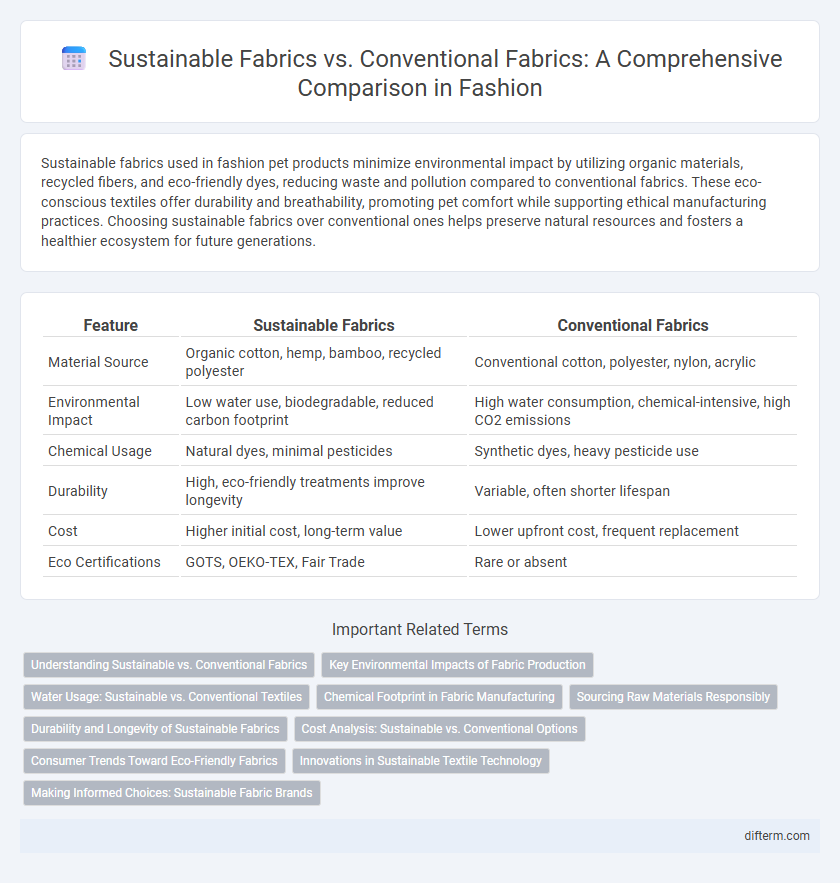Sustainable fabrics used in fashion pet products minimize environmental impact by utilizing organic materials, recycled fibers, and eco-friendly dyes, reducing waste and pollution compared to conventional fabrics. These eco-conscious textiles offer durability and breathability, promoting pet comfort while supporting ethical manufacturing practices. Choosing sustainable fabrics over conventional ones helps preserve natural resources and fosters a healthier ecosystem for future generations.
Table of Comparison
| Feature | Sustainable Fabrics | Conventional Fabrics |
|---|---|---|
| Material Source | Organic cotton, hemp, bamboo, recycled polyester | Conventional cotton, polyester, nylon, acrylic |
| Environmental Impact | Low water use, biodegradable, reduced carbon footprint | High water consumption, chemical-intensive, high CO2 emissions |
| Chemical Usage | Natural dyes, minimal pesticides | Synthetic dyes, heavy pesticide use |
| Durability | High, eco-friendly treatments improve longevity | Variable, often shorter lifespan |
| Cost | Higher initial cost, long-term value | Lower upfront cost, frequent replacement |
| Eco Certifications | GOTS, OEKO-TEX, Fair Trade | Rare or absent |
Understanding Sustainable vs. Conventional Fabrics
Sustainable fabrics like organic cotton, hemp, and recycled polyester reduce environmental impact by using fewer chemicals, less water, and promoting biodegradability compared to conventional fabrics such as regular cotton and synthetic fibers derived from fossil fuels. These eco-friendly materials support circular fashion by minimizing waste through recyclability and compostability, aligning with green manufacturing practices. Choosing sustainable fabrics contributes to lower carbon footprints and fosters ethical production chains, addressing the textile industry's pollution and resource depletion challenges.
Key Environmental Impacts of Fabric Production
Sustainable fabrics such as organic cotton, hemp, and recycled polyester significantly reduce water consumption and greenhouse gas emissions compared to conventional cotton and polyester production. Conventional fabric production relies heavily on pesticides, synthetic fertilizers, and non-renewable resources, leading to soil degradation, water pollution, and high carbon footprints. Choosing sustainable fabrics supports biodiversity, conserves natural resources, and minimizes textile waste in landfills, promoting a more eco-friendly fashion industry.
Water Usage: Sustainable vs. Conventional Textiles
Sustainable fabrics like organic cotton, hemp, and Tencel use significantly less water compared to conventional cotton, which consumes approximately 10,000 liters of water per kilogram produced. Innovations in textile manufacturing, such as closed-loop water systems and rainwater harvesting, drastically reduce water consumption in sustainable fabric production. Emphasizing sustainable textile choices can conserve billions of liters of water annually while minimizing environmental impact.
Chemical Footprint in Fabric Manufacturing
Sustainable fabrics significantly reduce the chemical footprint in fabric manufacturing by utilizing natural dyes, organic fibers, and eco-friendly treatments that minimize toxic runoff and soil contamination. Conventional fabrics often rely on synthetic fibers and chemical-intensive processes, leading to higher emissions of harmful substances such as azo dyes, formaldehyde, and heavy metals. Choosing sustainable textiles supports lower environmental impact and promotes healthier ecosystems by cutting down on pollutant discharge and hazardous waste production throughout the production cycle.
Sourcing Raw Materials Responsibly
Sustainable fabrics are derived from renewable resources like organic cotton, hemp, and bamboo, grown without harmful pesticides or synthetic fertilizers, reducing environmental impact at the source. Conventional fabrics often rely on non-renewable inputs and intensive chemical use, contributing to soil degradation and water pollution. Prioritizing responsible sourcing ensures raw materials support biodiversity, minimize carbon footprint, and promote fair labor practices within the fashion supply chain.
Durability and Longevity of Sustainable Fabrics
Sustainable fabrics such as organic cotton, hemp, and recycled polyester demonstrate superior durability compared to conventional fabrics due to their natural fiber strength and lower chemical processing. These materials maintain color, texture, and structural integrity longer, reducing the need for frequent replacements and minimizing environmental impact. Investing in sustainable textiles promotes longevity in fashion, supporting eco-friendly consumption and waste reduction.
Cost Analysis: Sustainable vs. Conventional Options
Sustainable fabrics like organic cotton, hemp, and bamboo often come with higher upfront costs compared to conventional materials such as polyester and conventional cotton due to eco-friendly farming practices and lower yields. Long-term savings emerge from sustainable options through reduced environmental impact, potential for recycling, and consumer demand for ethically made products boosting brand value. Conventional fabrics benefit from established supply chains and mass production, leading to lower initial prices but higher ecological costs and market volatility.
Consumer Trends Toward Eco-Friendly Fabrics
Rising consumer demand for sustainable fabrics like organic cotton, hemp, and Tencel signals a shift away from conventional textiles known for high water usage and chemical treatments. Market data reveals a 25% annual increase in eco-friendly fabric purchases driven by growing environmental awareness and preferences for biodegradable, renewable materials. Brands leveraging transparent supply chains and certifications such as GOTS and OEKO-TEX are gaining competitive advantage amid shifting consumer values toward sustainability in fashion.
Innovations in Sustainable Textile Technology
Innovations in sustainable textile technology have led to the development of biodegradable fibers such as Tencel and Pinatex, which reduce environmental impact compared to conventional cotton and polyester. Advanced processes like waterless dyeing and biofabrication using microbial cellulose minimize resource consumption and chemical waste. These breakthroughs not only enhance fabric performance but also support circular fashion by enabling easier recycling and composting of garments.
Making Informed Choices: Sustainable Fabric Brands
Sustainable fabric brands prioritize eco-friendly materials such as organic cotton, Tencel, and recycled polyester, drastically reducing environmental impact compared to conventional fabrics that rely heavily on water, pesticides, and non-renewable resources. Brands like Patagonia, Stella McCartney, and Eileen Fisher emphasize transparency in sourcing and manufacturing, enabling consumers to make informed decisions that support ethical production and durability. Choosing sustainable fabrics contributes to lower carbon footprints, reduced waste, and promotes a circular fashion economy.
sustainable fabrics vs conventional fabrics Infographic

 difterm.com
difterm.com